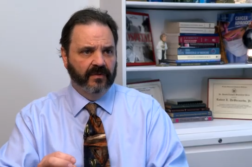LOS ANGELES, Calif. (Ivanhoe Newswire) — Lumbar spinal stenosis is a narrowing of the spinal canal that happens as we age, sometimes making it painful to stand and walk. Now, doctors are using Vertos Medical’s minimally invasive “MILD” procedure to treat patients and a brand new clinical trial is using popular technology to track improvement in mobility.
Just walking like this used to worry Ronnie Turner. He says numbness and pain from his lumbar spinal stenosis restricted his usually active lifestyle by 50 percent.
“I wanted help, and I wanted to be where I could do things with my grandkids and my son,” said Turner.
Turner had the MILD procedure. His doctor used contrast to find the narrowing, then through a tiny incision, removed small pieces of bone and ligament. A fluoroscope showed when the canal was open. Vance Johnson, MD, director spine service at Loma Linda University Medical Center, Murrieta Campus says there’s no guesswork with the MILD procedure.
Dr. Johnson said, “We can see while we’re operating actually, live while we’re operating, the canal open up and the pressure decrease.”
A band aid covered the incision. Ronnie was back to activity the next day. Now, Vertos Medical is running a study measuring real outcomes of its mild procedure, using Fit Bits. The face is covered, so patients don’t know how they’re doing during checks at six, 12 and 24 months. But a previous study showed that standing time increased from eight to 56 minutes and walking distance from 300 to 4,000 feet.
Eric Wichems, President and CEO of Vertos Medical said, “What we expect to see is a true improvement in the quality of life of these patients, and that’s new data.”
Turner says returning to fishing is proof enough for him: “I don’t dread the opportunity to go and do things. Those days are over. I’ll try anything!”
The motion study trial will also track opioid usage before and after the MILD procedure. It’s a 20 center randomized, controlled study that should have results in about a year and a half. If you’re interested in enrolling, go to http://www.mildprocedure.com/motion-study.html
Contributors to this news report include: Wendy Chioji, Field Producer; Rusty Reed, Videographer; Cyndy McGrath, Supervising Producer; Hayley Hudson, Assistant Producer; Robert Walko, Editor.
To receive a free weekly e-mail on Medical Breakthroughs from Ivanhoe, sign up at: http://www.ivanhoe.com/ftk
MEDICAL BREAKTHROUGHS
RESEARCH SUMMARY
TOPIC: FITBIT TRIAL FOR LUMBAR STENOSIS
REPORT: MB #4533
BACKGROUND: The lumbar spine is made up of 5 vertebrae that are in the lower back in between the ribs and the pelvis. Lumbar spinal stenosis is the narrowing of the spinal canal causing the nerves to travel through the lower back to the legs. This is mostly a degenerative condition found in those 60 and above, but it can be found in younger patients as well. The main causes of this condition are bone spurs or the discs becoming less spongy which leads to reduced disc height. This could cause symptoms, but there is a possibility they might not. Symptoms include numbness, pain or weakness in the legs, buttocks or calves, pain in one or both of the thighs, cramping in the calves while walking and in rare cases, loss of motor skills in the legs. X-rays, MRIs, and CT scans are the most common tests given to those with a possibility of lumbar stenosis. The imaging shows where bone spurs may be narrowing, or where there are damaged discs or ligaments.
(Source: https://www.aans.org/Patients/Neurosurgical-Conditions-and-Treatments/Lumbar-Spinal-Stenosis )
TREATMENTS: There are both nonsurgical and surgical options when it comes to treating this condition. Doctors can prescribe a set of different medications such as antidepressants, pain relievers, and anti-seizure drugs to help ease the pain. Physical therapy, steroid therapy and a decompression procedure are also options to help patients avoid surgery. The steroid injections reduce the inflammation and pain. For surgery, there are many types of surgeries that can be given. A laminectomy, or decompression surgery, takes out the back part of the infected vertebrae, or the lamina. There is also laminotomy, which carves a hole in the lamina to relieve pressure, and finally, laminoplatsy is surgery through the vertebrae in the neck creating space within the spinal canal.
(Source: https://www.mayoclinic.org/diseases-conditions/spinal-stenosis/diagnosis-treatment/drc-20352966
NEW TECHNOLOGY: There is now a new surgery that can help lumbar spinal stenosis patients. It is a minimally invasive surgery. This option removes the lamina, protecting the healthy tissue around it from damage. Dr. Vance Johnson says that the problem with other surgeries is the scars can cause more problems down the road. This procedure does not require hardware. Patients recover quickly, as compared to having to recover over months.
(Source: https://www.mayoclinic.org/diseases-conditions/spinal-stenosis/diagnosis-treatment/drc-20352966
FOR MORE INFORMATION ON THIS REPORT, PLEASE CONTACT:
James Chisum
714-496-0541
If this story or any other Ivanhoe story has impacted your life or prompted you or someone you know to seek or change treatments, please let us know by contacting Marjorie Bekaert Thomas at mthomas@ivanhoe.com




